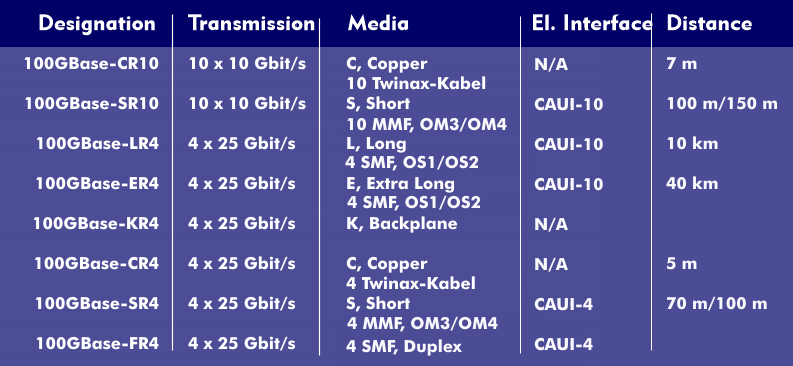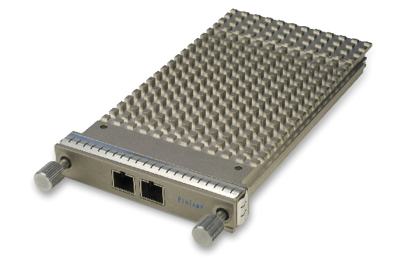100GbE interface
100GbE interfaces are specified by the Ethernet working group802.3ba for 100 Gigabit Ethernet. The interface designations are subject to a predefined Ethernet nomenclature consisting of the abbreviation 100GBase followed by a variant designation consisting of two letters and a digit, e.g. 100GBase- SR-4.
100G stands for 100 gigabits per second and BASE for baseband. In the letter combination, the first letter stands for the transmission medium and length, the second letter (R) for the 64B66B coding, and the digit tells how many parallel lines the interface operates with.
The interfaces for optical fibers
In the first phase, 802.3ba specified three FOC interfaces. For single- mode fibers, these are the 100GBase-ER4 and 100GBase-LR4 interfaces, each of which transmits 25 Gbit/s over four WDM paths of a single-mode fiber. These variants are designed for distances of 40 km and 10 km and are aimed at use in metro networks. In addition, there is the 100GBase-SR10 for multimode fibers with OM classes 3 and 4, which transmits 10 Gbit/s each over ten wavelength division multiplexing paths or ten multimode fibers.
100GbE over copper cable
As for transmission over twinaxial cables, for 40 Gigabit Ethernet there is the 40GBase-CR4 interface, which uses four parallel copper lines at 10 Gbit/s each, and for 100 Gigabit Ethernet there is the 100GBase-CR10, which uses ten parallel lines at 10 Gbit/s each. Both physical copper interfaces support distances of up to 10 m and, like the solutions with multimode fibers, are aimed at core and aggregation applications in data centers. The 100GbE interfaces are technically implemented with optical transceivers in pluggable CXP or CFP modules.
After 2010, additional 100-Gigabit Ethernet interfaces were specified, namely 100GBase-KR4, 100GBase-CR4, 100GBase-SR4 and 100GBase-FR4. These interfaces are referred to as 2nd generation 100GbE interfaces. 100GBase-KR4 is for backplanes and transmits 4 x 25 Gbps, 100GBase-CR4 is a copper cable interface with 4 x 25 Gbps, 100GBase-SR4 is for four OM class 3 multimode fibers, and 100GBase-FR4 is for 4 x 25 Gbps over single mode fiber with a bridgeable distance of 2 km. The 100 Gigabit Attachment Unit Interface( CAUI) is in QSFP modules and CFP modules.
Later, the 802.3cd working group added another interface for 100 Gigabit Ethernet, in terms of a higher data rate. Thus, 100 Gigabit can be transmitted via the interface 100GBase-CR2 over two lanes, 100GBase-KR2 supports backplane Ethernet in data centers, 100GBase- DR can transmit 100GbE over a single-mode lane consisting of two single-mode fibers, and 100GBase-SR2 transmits over two lanes consisting of four multimode fibers.
Based on the technologies mentioned, 200 Gigabit Ethernet( 200GbE) can also be transmitted. The following interfaces are available for this: 200GBase-CR4 with four lanes of twinaxial cable, 200GBase-KR4 for backplanes and 200GBase-SR4 via eight multimode fibers.


